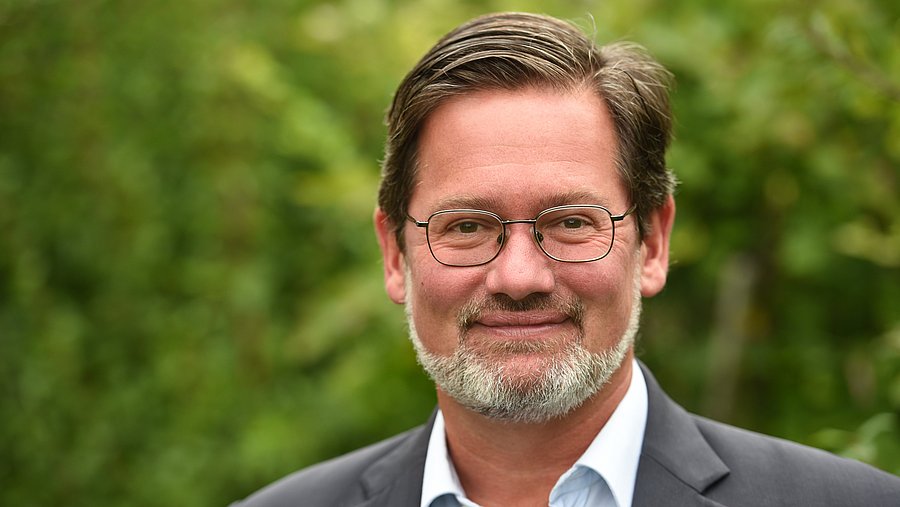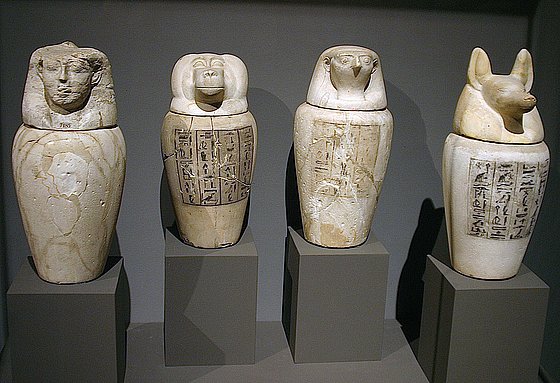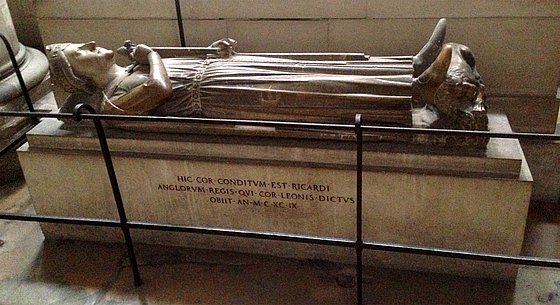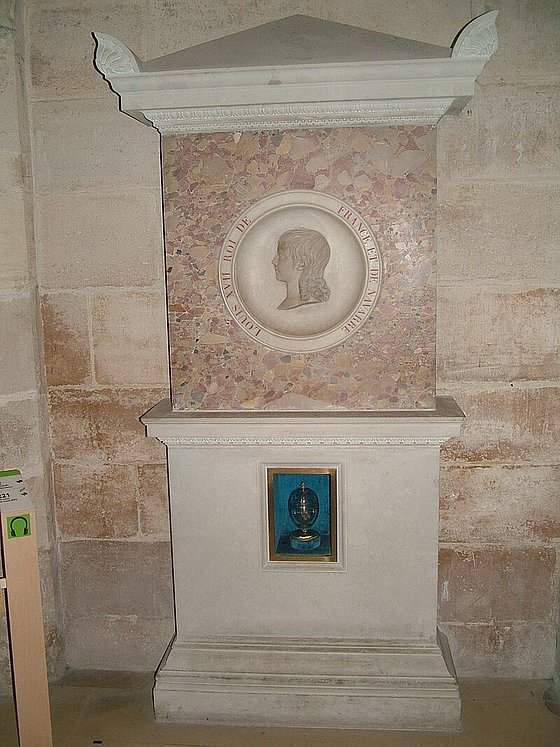
Lordly burial rites
PD Dr Arne Karsten / History
Photo: Sebastian Jarych
The religious, social and political components of separate burial
The historian Dr Arne Karsten on lordly burial rites
'Here lies the heart of Richard, King of England' - this sentence is written on a lead casket that was discovered in 1838 during excavations in Rouen Cathedral in France. In 1199, the embalmed heart of Richard the Lionheart was buried wrapped in the finest linen. His body, meanwhile, rests in Fontevraud Abbey in Anjou. This form of burial, which already existed among the ancient Egyptians is called separate burials. “After death, the body is disembowelled, the entrails are removed and part of the entrails are buried separately from the body in a different place,” historian Arne Karsten explains. He teaches modern history at the University of Wuppertal. The heart was very often buried separately, but other organs such as the eyes, brain or even the tongue were usually placed in copper containers in alcohol. Then the containers were soldered shut and the organs were laid to rest elsewhere.

Canopic jars. Egyptian Museum Berlin
Photo: CC BY-SA 2.5
The first European separate burial took place in 1056
Separate burials took place among the ancient Egyptians as early as 2500 BC. One of the first historically documented separate burials in Europe was the heart burial of the Salian Emperor Henry III (†1056). The Crusaders also used this method of separating corpses. “There were very practical reasons for this type of burial,” Karsten says, ”because it took far too long to transport a corpse from the Holy Land to the homeland using the technical possibilities of the Middle Ages. In these circumstances, it was a matter of practical common sense to leave the corpse in one place and then transport part of it, such as the heart, over longer distances in a dried state.”

The tomb of Richard the Lionheart in Rouen Cathedral, where his heart was buried
Photo: public domain
Several burial sites also demonstrated claims to power
Richard the Lionheart rests in Anjou, his heart was laid to rest in the centre of his rebellious province, Normandy, in Rouen Cathedral. This also demonstrated the claim to power over parts of the realm beyond death. “The burial of the body has a religious component, but in the Middle Ages it also had a social and political component,” the historian explains, “because the presence of the deceased serves as a legitimisation for the world of those who live on. It is a world in which claims to power are justified by tradition. This concept is also a difference to the present with our fetish for innovation. Today, we have to 'reinvent' ourselves constantly. The pre-modern world thinks very differently: the old, the tried and tested, is the good, tradition is something that legitimises.”

Tomb of Louis XVII in Saint-Denis
Photo: public domain
Veneration of relics
This type of burial also has to do with the veneration of relics. “That's basically where it comes from, even if they should be clearly distinguished from one another”, Karsten explains. “The veneration of relics is in honour of a deceased saint whose prayer as an intercession with God is important for people in the present in their lives and also after their death. This is one way of thinking about religion. The burial of the body of a non-saint, a powerful person, is linked to this without being identical with it. The saint is honoured as an intercessor with God; at the tomb of a deceased non-saint, one prays for him, not for his intercession.” This is why this multiple burial is so interesting: prayers can be said in different places for the salvation of the deceased sinner. “Intercession is important for existence in the afterlife. The basic idea is that, according to Christian doctrine, the real life takes place after death, the eternal life. In hell or heaven, and for most of us mediocre sinners, first in purgatory. However, the stay in purgatory as a place of purification for sins committed in life can be shortened by the intercession of saints with God. That is the idea behind the cult of relics.”
Heart burial also had political significance
During the Counter-Reformation, the Jesuits, among others, tried to obtain prominent hearts for their churches and to promote this custom in order to secure the goodwill of the families concerned. The burial of hearts therefore also became political significant. ”It has always had that and it is difficult to separate it from its religious significance.” Karsten gives a concrete example: ”I would like to cite the Würzburg Prince-Bishop Julius Echter von Mespelbrunn, who died in 1617, as an example of the instrumentalization of burial. He was regarded as a very committed bishop, active as a benefactor, a counter-reformer, also politically savvy, who made a large number of endowments. He founded the Juliusspital in Würzburg, which still exists today, as well as the new University of Würzburg, among other things. Then he did something interesting in this context. He deviated from a centuries-old tradition of the Würzburg bishops to bury their hearts in Ebrach Abbey and, at his explicit wish, had his heart buried in the university church to prove his attachment to this foundation, which was particularly close to his heart, even after his death.”
Separate burials of the high nobility officially ended in 1878
Separate burials were very common among members of the aristocracy and clerics throughout Europe. Since the 17th century, the Austrian Habsburg dynasty had particularly cultivated this ritual, and although this protocol was officially ended in 1878, the last imperial funeral of this kind only took place in 1989 in front of 6,000 mourners. “And that was Empress Zita of Bourbon-Parma, the wife of the last Habsburg emperor, who died in 1925. You can see from this how this tradition is literally internalised, that it has been practised far beyond the Habsburg family's period of political influence right up to the present day.”
In addition to the high nobility and clergy, commoners were also buried separately. Frederic Chopin and Lord Byron are well-known examples. “Here, too, you can symbolise a connection with a particular place beyond death. What applies to the clergy and the powerful also applies to the artist,” Karsten says, “this prominence beyond death was obviously of general interest.”
Poland claims the heart of Pope John Paul II.
People are still fascinated by heart burials today. According to a report by CNN, in 2005 the Poles demanded the heart of Pope John Paul II to be buried at Wawel Castle in Krakow alongside other great Polish people. ”In the case of John Paul II, we must not forget that during the communist era, the Catholic Church in Poland formed an extremely important opposition to the communist party's claims to social omnipotence”, Karsten comments. “This role is of particular importance because John Paul II was elected in 1978 during the Cold War, and this has not been forgotten in Poland. This outstanding position of the first pope to come from Poland would like to be expressed by materially expressing this connection through the heart.”

Heart urn of the Dauphin
Photo: public domain
Media-effective heart burial of the last dauphin 209 years later
The story of the heart urn of the last heir to the French throne, Louis XVII, is also spectacular. When the 10-year-old child died in prison in 1795, the doctor kept the preserved heart. In 2000, modern analyses identified the heart tissue as that of the Dauphin. As a result, the heart urn was reburied on 8 June 2004 in Saint-Denis next to the sarcophagi of his parents with the participation of the European aristocracy. "This shows that the question of tradition is still characteristic of the aristocratic world of thought to this day. The commoner is defined by his achievements, the aristocrat is something, namely by the tradition of his family."
In the modern age, these traditions have become increasingly lost. ”The dead are among the biggest losers of the modernisation process,” Karsten states unequivocally, ”because the past reminds us of the tombstones, the multiple burials and the connection between the deceased and posterity.” Since 2009, Karsten has been in charge of the project ” Requiem – Die römischen Papst- und Kardinalgräber der frühen Neuzeit” (Requiem - The Roman Papal and Cardinal Tombs of the Early Modern Period), which was initiated at Humboldt University. The aim is to record the tombs and funerary monuments of popes and cardinals, their design, period of origin, patrons and artists involved and to make them accessible to all scholars in an interdisciplinary database. ”Today, anonymous urn burial is the order of the day,” he concludes, ”and this is where a completely different world is expressed.”
Further information on the project: https://requiem-projekt.de/
Uwe Blass
PD Dr Arne Karsten (*1969) studied art history, history and philosophy in Göttingen, Rome and Berlin. From 2001 to 2009, he was a research assistant at the Department of Art and Visual History at Humboldt-Universität zu Berlin. He has been teaching as a junior professor since the 2009 winter semester and as a private lecturer in modern history at the University of Wuppertal since his habilitation in 2016.
